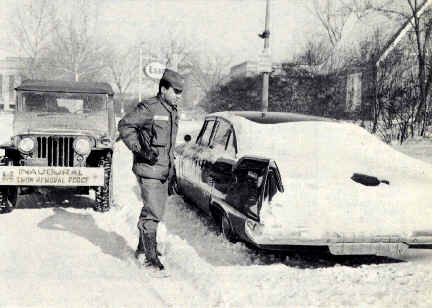"Friday will be cold and windy with some sunshine and a high of not more than 35 degrees." That was the Washington, D.C., advanced weather forecast for John F. Kennedy's Inauguration Day, 20 January 1961. "Some rain, possibly changing to light snow," was later predicted for the 19th. Still, inaugural planners remained confident that whatever happened, their plans to cope with adverse weather would surmount anything Mother Nature might have in store. What actually transpired taxed local and federal resources to the maximum.
Snow on the afternoon of the 19th became so heavy that federal workers were sent home early. They mixed with scores of inaugural visitors, and a monumental traffic jam ensued. Throughout the region, thousands of vehicles ran out of gas or were abandoned. Pre-Metro public transportation came to a grinding halt. By daybreak, "light" snowfall amounted to nearly 8 inches in the city and much more in outlying areas.

An Engineer soldier from the Inaugural Snow Removal Force sizes up the job of moving one
of many D.C. cars abandoned after the surprise pre-inaugural snowfall of 1961.
Fortunately, the 87th Engineer Battalion, stationed at Fort Belvoir and commanded by LTC Joseph C. Dyer, was part of the Snow Emergency Plan. At 2 p.m. on the 19th, Dyer ordered into action the nearly 700 troops from the 87th , augmented by elements of the 79th Engineer Group, two other battalions, five companies, and the Engineer School Construction Branch. By 7 p.m. a massive cleanup effort was under way.
District Engineer Commissioner BG Frederick J. Clarke and D.C. Sanitation Director William A. Xanten, joined by Dyer, oversaw the operation from emergency headquarters in the District Building. The Engineers teamed up with more than 1,000 District of Columbia employees to clear the inaugural parade route. Luckily much equipment and some men had been pre-positioned and were ready to go. In the end the task force employed hundreds of dump trucks, front-end loaders, sanders, plows, rotaries, and even flamethrowers to clear the way. District and Army equipment worked side-by-side to move more than 1,400 cars from the inaugural route. Another contingent of troops cleared the reviewing stands and bleachers at the White House and U.S. Capitol. Some 1,700 Boy Scouts joined in similar efforts along the parade route.
As dawn approached, continuing flurries and high winds threatened to undo some of the night’s hard work, but within a few hours the parade route was passable. Skies soon cleared and the ceremonies went ahead as planned. Recalling those grueling hours, LTG Clarke, retired Chief of Engineers, still vividly remembers the superb leadership of Xanten and Dyer, and the dedicated teamwork of the District's sanitation workers and Engineer troops. What could have been an inauspicious beginning to John F. Kennedy’s presidency turned out to be a memorable success.

Inauguration of President Kennedy on east portico of U.S. Capitol, 20 January 1961.
* * *
2000